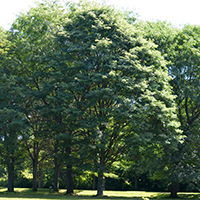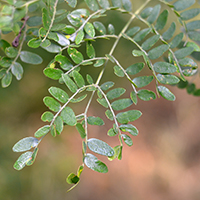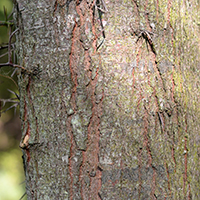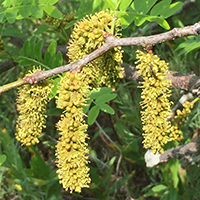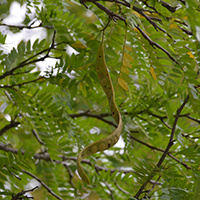What honey locust looks like
Size and shape
- Reaches 30 metres high.
- Trunk up to 90 centimetres in diameter.
Leaves
- Green compound leaves that turn yellow in fall.
- Composed of many leaflets (25 to 40 millimetres) that can have round or pointed tips.
Bark
- Brown bark that is smooth with horizontal markings when young.
- Becomes furrowed and ridged with age.
- Thorns can cover bark.
Flowers
- Greenish white flowers that emerge in spring with leaves.
- Flowers grow in clusters (5 to 9 centimetres).
Fruit
- Brown pods (15 to 40 centimetres long).
- Flat, twisted and leathery exterior.
Where honey locust is found
Honey locust only grows naturally — but is not common — in parts of Southwestern Ontario near Lake Erie. However, due to its popularity as a landscaping tree, honey locust can be found beyond its natural range throughout Southern Ontario.
What you need to know to grow honey locust
- Moisture: grows best in moist, well-drained soils, but tolerates some drought and flooding.
- Soil: grows best in loam or clay but tolerates a range of soils.
- Shade: grows best in full sun.
- Cautions:
- Some honey locusts have thorns, which can cause injuries. Consider planting thornless varieties.
- Honey locust borer: larvae can tunnel under the bark and through larger branches but is not a common problem in Ontario. Honey locust borer is commonly mistaken for emerald ash borer.
Benefits and uses of honey locust
Wildlife benefits
Honey locust pods are a food source for many species, including:
- white-tailed deer
- squirrels
- cattle
The flowers are a food source for bees. Honey locust trees are also used by wildlife for cover and nesting sites.
Commercial uses
Honey locust wood is commonly used to make fence posts and was historically used to create bows.
Honey locust is also used as shade trees and windbreaks because of its large canopy.
Fun facts about honey locusts
- Honey locust fruit has been used to make beer.
- Honey locust trees can grow more than 60 centimetres in height per year.
- Honey locust seeds are dispersed by wildlife that consume pods.
Updated: November 22, 2023
Published: August 22, 2023
